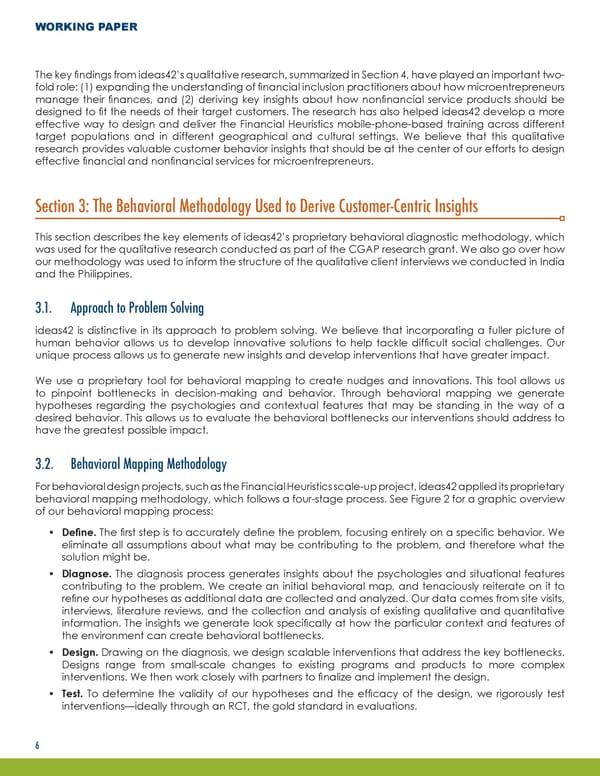WORKING PAPER The key findings from ideas42’s qualitative research, summarized in Section 4, have played an important two- fold role: (1) expanding the understanding of financial inclusion practitioners about how microentrepreneurs manage their finances, and (2) deriving key insights about how nonfinancial service products should be designed to fit the needs of their target customers. The research has also helped ideas42 develop a more effective way to design and deliver the Financial Heuristics mobile-phone-based training across different target populations and in different geographical and cultural settings. We believe that this qualitative research provides valuable customer behavior insights that should be at the center of our efforts to design effective financial and nonfinancial services for microentrepreneurs. Section 3: The Behavioral Methodology Used to Derive Customer-Centric Insights This section describes the key elements of ideas42’s proprietary behavioral diagnostic methodology, which was used for the qualitative research conducted as part of the CGAP research grant. We also go over how our methodology was used to inform the structure of the qualitative client interviews we conducted in India and the Philippines. 3.1. Approach to Problem Solving ideas42 is distinctive in its approach to problem solving. We believe that incorporating a fuller picture of human behavior allows us to develop innovative solutions to help tackle difficult social challenges. Our unique process allows us to generate new insights and develop interventions that have greater impact. We use a proprietary tool for behavioral mapping to create nudges and innovations. This tool allows us to pinpoint bottlenecks in decision-making and behavior. Through behavioral mapping we generate hypotheses regarding the psychologies and contextual features that may be standing in the way of a desired behavior. This allows us to evaluate the behavioral bottlenecks our interventions should address to have the greatest possible impact. 3.2. Behavioral Mapping Methodology For behavioral design projects, such as the Financial Heuristics scale-up project, ideas42 applied its proprietary behavioral mapping methodology, which follows a four-stage process. See Figure 2 for a graphic overview of our behavioral mapping process: • Define. The first step is to accurately define the problem, focusing entirely on a specific behavior. We eliminate all assumptions about what may be contributing to the problem, and therefore what the solution might be. • Diagnose. The diagnosis process generates insights about the psychologies and situational features contributing to the problem. We create an initial behavioral map, and tenaciously reiterate on it to refine our hypotheses as additional data are collected and analyzed. Our data comes from site visits, interviews, literature reviews, and the collection and analysis of existing qualitative and quantitative information. The insights we generate look specifically at how the particular context and features of the environment can create behavioral bottlenecks. • Design. Drawing on the diagnosis, we design scalable interventions that address the key bottlenecks. Designs range from small-scale changes to existing programs and products to more complex interventions. We then work closely with partners to finalize and implement the design. • Test. To determine the validity of our hypotheses and the efficacy of the design, we rigorously test interventions—ideally through an RCT, the gold standard in evaluations. 6
 Using Behavioral Science to Design a Customer-Centric Financial Management Training for Microentrepreneurs Page 8 Page 10
Using Behavioral Science to Design a Customer-Centric Financial Management Training for Microentrepreneurs Page 8 Page 10